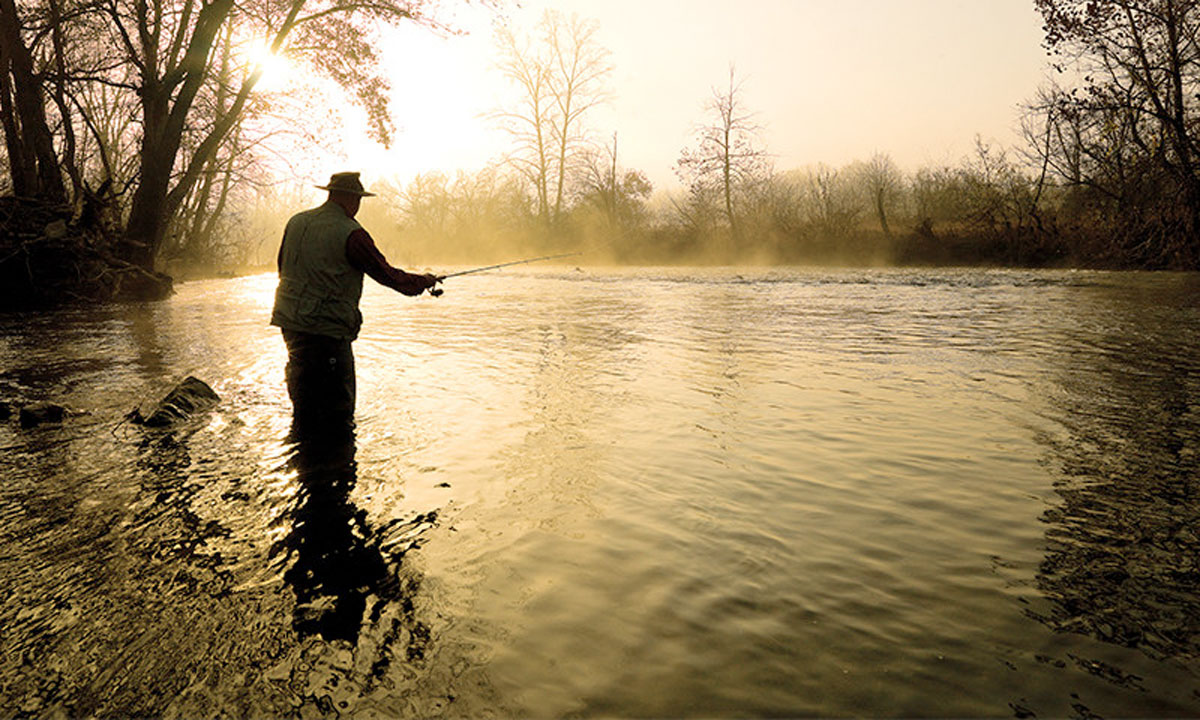During the past week, we have had no rain, warm temperatures and moderate winds. The lake level at Bull Shoals fell six tenths of a foot to rest at one and eight two feet above power pool of 661 feet. This is thirty two and eight tenths feet below the top of flood pool. Upstream, Table Rock Lake fell one and four tenths feet to rest at one and five tenths feet below power pool and fifteen and five tenths feet below the top of flood pool. Beaver Lake fell four tenths of a foot to rest at nine tenths of a foot below power pool or nine and five tenths feet below the top of flood pool. On the White, we have had two days of wadable water. Norfork Lake fell six tenths of a foot to rest at two tenths of a foot above power pool of 555.8 feet and twenty four feet below the top of flood pool. On the Norfork, we have had three days of wadable water.
The water level for the top of power pool has been reset higher for all of the lakes in the White River system. With Beaver and Table Rock Lakes below power pool and Bull Shoals and Norfork near power pool and dropping fast, I predict that both will be at power pool in a few days and we should return to wadable water then.
On the White, the hot spot has been Rim Shoals. On the low water, the bite was excellent! The hot flies were Y2Ks, prince nymphs, zebra midges (black with silver wire and silver bead or red with silver wire and silver bead), pheasant tails, copper Johns, pink and cerise San Juan worms, gold ribbed hare’s ears and sowbugs. Double fly nymph rigs have been very effective. Try a small bead headed nymph (zebra midge, copper John or pheasant tail) suspended eighteen inches below a brightly colored San Juan worm (hot fluorescent pink or cerise).
On the higher flows some anglers have been fishing large streamers on the heavy flows we have been getting later in the day and having success. This requires heavy sink tip lines (250 grain), heavy rods (eight weights or better) and advanced casting skills. The hot flies have been large articulated streamers in various colors.
Hopper season is on the wane. These are tempting morsels for large trout. You need a stiff six weight rod and a seven and a half foot 4X leader. My favorite hopper patterns are the western style foam hoppers with rubber legs and a bright quick sight patch on the back. Dave’s hoppers are also a good choice but be sure to dress them with plenty of fly floatant to ensure that they ride high. A small nymph dropper can increase your takes. It is not uncommon to take more trout on the dropper. My favorite dropper flies are beadhead pheasant tails or zebra midges.
Crooked Creek and the Buffalo River are low and gin clear. Both are receiving a lot of pressure. With summer coming to an end, the smallmouths are still active. The most effective fly has been a tan and brown Clouser minnow. Carefully check the water level before entering Crooked Creek or the Buffalo River. There are no dams on these streams. They both have large drainages and are prone to flooding during and following any rain event. The water can rise very quickly.
There has been wadable water on the Norfork and it fished well. The most productive flies have been small midge patterns like zebra midges (black or red with silver wire and silver bead). Grasshoppers have produced fish, particularly when used in conjunction with a small nymph dropper (try a size 20 black zebra midge). Double fly nymph rigs have been very effective. Try a small bead headed nymph (zebra midge, copper John or pheasant tail) suspended eighteen inches below a brightly colored San Juan worm (hot fluorescent pink or cerise). The fishing is much better in the morning and late afternoon and tapers off midday.
Dry Run Creek has fished well. School is back in session and now is a great time to fish it, particularly during the week. Weekends can get a bit crowded. The hot flies have been sowbugs and various colored San Juan worms (worm brown, red, hot fluorescent pink and cerise). Small orange or peach eggs have been very effective. Be sure and carry a large net, as most fish are lost at the net.
The water level on the Spring River is fishable. This is a great place to wade fish, when they are running water on the White and Norfork Rivers. Canoe season is coming to an end but canoeists can still be a problem. Fish the upper river at the Lassiter Access to avoid them or fish Dam Three late in the afternoon, after they have left the area. Be sure to wear cleated boots and carry a wading staff. There is a lot of bedrock that can get very slick. The hot flies have been olive woolly buggers with a bit of flash, cerise and hot pink San Juan worms and Y2Ks.
Remember that the White and Norfork Rivers and Dry Run Creek are infected with didymo, an invasive alga. Be sure and thoroughly clean and dry your waders (especially the felt soles on wading boots) before using them in any other water. Many manufacturers are now making rubber soled wading boots that are easier to clean and are not as likely to harbor didymo.
John Berry is a fly fishing guide in Cotter, Arkansas and has fished our local streams for over thirty years. John can be reached at (870) 435-2169 or http://www.berrybrothersguides.com.



